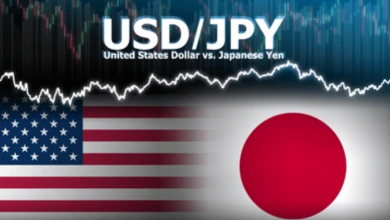JPY sticks to intraday gains; USD/JPY struggles near 146.00 amid softer USD
- The Japanese Yen remains on the front foot against a softer USD for the third straight day.
- Bets that the BoJ will hike rates again and a weaker risk tone underpin the safe-haven JPY.
- The emergence of fresh USD selling also exerts downward pressure on the USD/JPY pair.
The Japanese Yen (JPY) sticks to its positive bias through the Asian session on Thursday, which, along with the emergence of some US Dollar (USD) selling, exerts some downward pressure on the USD/JPY pair for the third successive day. Japan’s wholesale inflation data released on Wednesday indicated that companies continued to pass on costs to consumers and added to fears of more entrenched price increases in Japan. Moreover, the Bank of Japan (BoJ) Deputy Governor Shinichi Uchida’s hawkish comments earlier this week back the case for further policy tightening, which, in turn, is seen as a key factor lending support to the JPY.
Apart from this, a slight deterioration in the global risk sentiment – as depicted by a generally weaker tone around the equity markets – is seen as another factor underpinning the safe-haven JPY. The USD, on the other hand, struggles to attract any buyers as traders opt to wait for the release of the US Producer Price Index (PPI) and Federal Reserve (Fed) Chair Jerome Powell’s appearance later today. In the meantime, the optimism over the de-escalation of the US-China trade war might keep a lid on the JPY. Moreover, reduced bets for more aggressive policy easing by the Fed could help limit losses for the USD and the currency pair.
Japanese Yen bulls retain intraday control amid BoJ rate hike bets and softer risk tone
- Japan’s Producer Price Index (PPI) released on Wednesday highlighted persistent price pressure and backs the case for further monetary policy normalization by the Bank of Japan. Moreover, BoJ Deputy Governor Shinichi Uchida reiterated that the central bank will keep raising rates if the economy and prices improve as projected.
- Meanwhile, investors turned cautious ahead of Thursday’s release of the US Producer Price Index and Federal Reserve Chair Jerome Powell’s appearance later during the North American session. This further contributes to the Japanese Yen’s relative outperformance against its American counterpart for the third consecutive day.
- In the meantime, a softer-than-expected US Consumer Price Index released on Tuesday reaffirmed market bets that the Fed will cut interest rates further. This, in turn, fails to assist the US Dollar to capitalize on the overnight bounce from the weekly low and further contributes to the offered tone surrounding the USD/JPY pair.
- Traders, however, have scaled back their expectations for a more aggressive policy easing by the Fed in the wake of the US-China trade optimism, which helped to ease recession fears. This might hold back the USD bears from placing fresh bets and keep a lid on any further appreciating move for the safe-haven JPY.
- Chicago Fed President Austan Goolsbee noted that some parts of the April inflation report represent the lagged nature of the data, and it will take time for current inflation trends to show up in the data. Right now is a time for the Fed to wait for more information, try to get past the noise in the data, Goolsbee added further.
- Separately, Fed Vice Chair Philip Jefferson said that the recent inflation data is consistent with further progress toward the 2% goal, but the future path remains uncertain due to trade tariffs. Jefferson also noted that the current moderately restrictive policy rate is in a good place to respond to economic developments.
- Furthermore, San Francisco Fed President Mary Daly said that solid growth, a solid labor market, and declining inflation are where we want to be. Monetary policy is well-positioned, moderately restrictive, and the Fed can respond to whatever comes into the economy, Daly added further.
USD/JPY bears await beak below the 146.00 mark before positioning for further losses

From a technical perspective, the USD/JPY pair struggles to capitalize on the overnight bounce beyond the 23.6% Fibonacci retracement level of the recovery from the year-to-date low set in April. Moreover, negative oscillators on hourly charts support prospects for a further intraday slide below the 146.00 mark, towards retesting the 145.60 area or the weekly low set on Wednesday. This is followed by the 38.2% Fibo. level, around the 145.35-145.30 region, below which spot prices could fall to the 145.00 psychological mark en route to the 144.70-144.65 zone. The latter represents the 200-period Simple Moving Average (SMA) resistance breakpoint on the 4-hour chart and should act as a key pivotal point. A convincing break below will suggest that the recent recovery from the year-to-date low has run out of steam and pave the way for deeper losses.
On the flip side, the 146.60 area (23.6% Fibo. level) could offer immediate resistance ahead of the 147.000 round figure. A sustained strength beyond the latter might trigger an intraday short-covering rally and lift the USD/JPY pair to the 147.70 intermediate hurdle en route to the 148.00 round figure. Any further move up beyond the 148.25-148.30 hurdle might face stiff resistance near the 148.65 area, or over a one-month peak touched on Monday, which, if cleared, should allow spot prices to reclaim the 149.00 mark.
US Dollar PRICE Today
The table below shows the percentage change of US Dollar (USD) against listed major currencies today. US Dollar was the strongest against the New Zealand Dollar.
| USD | EUR | GBP | JPY | CAD | AUD | NZD | CHF | |
|---|---|---|---|---|---|---|---|---|
| USD | -0.17% | -0.10% | -0.45% | -0.09% | -0.05% | 0.09% | -0.24% | |
| EUR | 0.17% | 0.06% | -0.26% | 0.08% | 0.12% | 0.27% | -0.07% | |
| GBP | 0.10% | -0.06% | -0.35% | 0.02% | 0.04% | 0.23% | -0.11% | |
| JPY | 0.45% | 0.26% | 0.35% | 0.37% | 0.40% | 0.53% | 0.22% | |
| CAD | 0.09% | -0.08% | -0.02% | -0.37% | 0.05% | 0.20% | -0.13% | |
| AUD | 0.05% | -0.12% | -0.04% | -0.40% | -0.05% | 0.15% | -0.15% | |
| NZD | -0.09% | -0.27% | -0.23% | -0.53% | -0.20% | -0.15% | -0.31% | |
| CHF | 0.24% | 0.07% | 0.11% | -0.22% | 0.13% | 0.15% | 0.31% |
The heat map shows percentage changes of major currencies against each other. The base currency is picked from the left column, while the quote currency is picked from the top row. For example, if you pick the US Dollar from the left column and move along the horizontal line to the Japanese Yen, the percentage change displayed in the box will represent USD (base)/JPY (quote).






